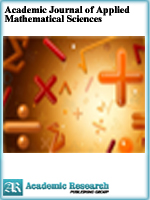Academic Journal of Applied Mathematical Sciences
Online ISSN: 2415-2188
Print ISSN: 2415-5225
Print ISSN: 2415-5225
Quarterly Published (4 Issues Per Year)

Archives
Volume 10 Number 1 July 2024
New Way for Solving Naiver - Stokes Equation
Authors: Tian-Quan Yun
Pages: 7-13
DOI: doi.org/10.32861/ajams.101.7.13
Abstract
This paper gives a new way for solving Navier - Stokes equation (N - S equation for short in following) by using following steps: Step 1, Sets up Wind - Pressure/density equation (1), suits for points in air (na∈A=∪na) and solves solutions ua and pa/ρa. (1 s). Step 2. Sets up Wave equation, described by NS equation (2), suits for points in sea (ns∈S=∪ns), and solutions us and ps/ρs. (2s) (unknown) Step 3. Sets up Wind - Wave equation (3), by (3) = (1) ∩ (2), suits for points in boundary between air and sea. (nas∈A∩S) and their solutions: ua,us and pa/ρa , ps/pa/ρa, .(3s). Step 4. Sets up boundary conditions by For differential form, ua= us and pa/pa = ps/pa. (4s1). For integral form. The wind dynamic energy = Potential energy of the high of sea. (4s2). Now, we have : the solutions of (2s) is solved by (3s) and by (4s1), i.e., ua = us and pa/ρa = ps/ρs. Or (1) = (2) . Then (2) is solved.
Asymptotic Series of the Associated Legendre Function with Respect to Seismic Surface Waves
Authors: Mitsuru Yoshida
Pages: 1-6
DOI: doi.org/10.32861/ajams.101.1.6
Abstract
The asymptotic series of the associated Legendre function is investigated for the angular degrees n=2-13 in the context of the amplitude and wavelength of seismic surface waves. The approximate formula for the associated Legendre function is used to determine the wavelength and phase velocity of free oscillations of the Earth and long-period surface waves. The approximate formula is derived from the first term of the asymptotic series and its error increases with decreasing n. In the present study, the effect of higher terms on the approximate formula is studied with respect to the amplitudes of the 1st term (a1), the 2nd term (a2), and the 3rd term (a3). For the colatitude angle θ of π/3≦θ≦2π/3, the amplitude ratios a2/a1 are approximately 3.5%-1.0% for n=2-11 and are less than 1.0% for n ≧ 12, while the amplitude ratios a3/a1 are approximately 0.4% - 0.03% for n=2-13. The effect of amplitudes of higher terms on the 1st term increases as the colatitude angle approaches the pole or the antipode. The wavelengths of the 1st term (λ1) , the 2nd term (λ2) , and the 3rd term (λ3) are in the sequence λ1 >λ2 >λ3. The wavelength ratiosλ2 /λ1 and λ3 >λ1 for n=2-13 are 0.71%-0.93% and 0.55%-0.87%, respectively. The relationship of the wavelengths between the different angular degrees may be expressed as λ n k =λn-1k+1, where n and k are respectively the angular degree and the ordinal number of the asymptotic series.



